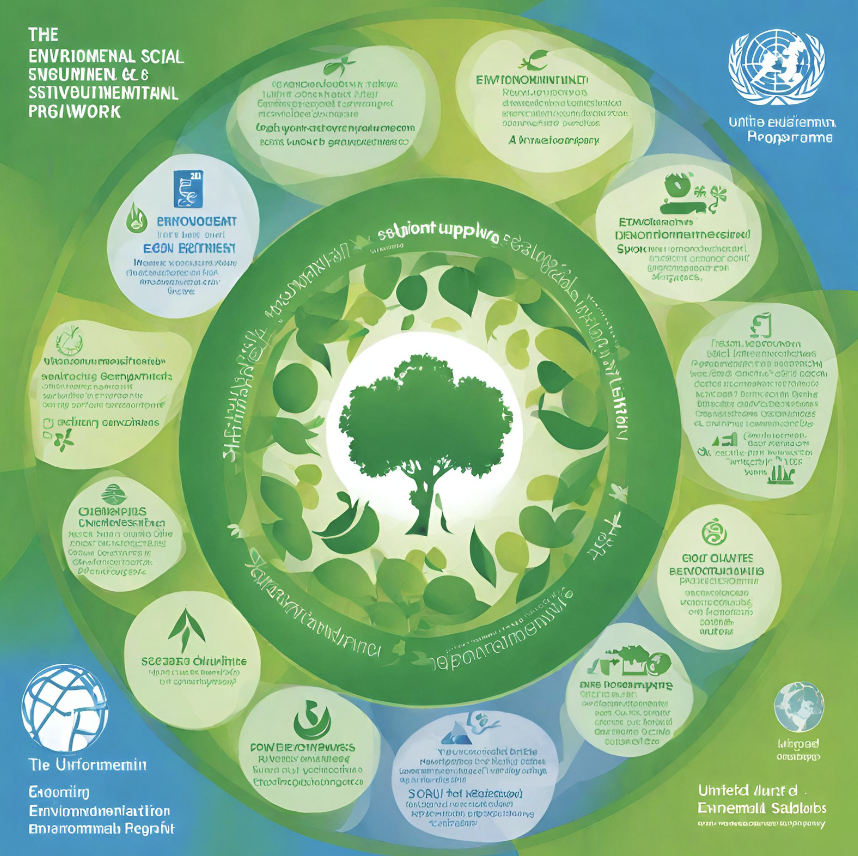
Author: Medha Shah
I. Introduction
In a world with rising environmental challenges and social disparity, it’s crucial to have a structure to strengthen the sustainability and accountability of the United Nations Environmental Programme (UNEP). The program’s integration of environmental and social sustainability principles has gained traction while it creates a cohesive approach to address global issues. This framework enables UNEP to apply efficient management of environmental and social impacts throughout a project. This article explores the pivotal role of the Environmental and Social Sustainability Framework within the context of the UNEP and in advancing the 2030 Agenda for Sustainable Development.
Explanation of the environmental and social sustainability framework
The Environmental and Social Sustainability Framework is a risk-informed approach taken by the UNEP to serve as a roadmap to carry out the UNEP’s priority to sustainable developmental, social, and environmental standards that promote human well-being and ecological protection and address addressing environmental and social risks and impacts. These standards integrate into preparing and implementing UNEP programs and projects to realize rights and enhance program outcomes. Revised from the former Environmental, Social, and Economic Sustainability Framework (ESESF), the ESSF seeks to capture lessons from the organization’s experiences to align with international standards and the 2030 Agenda. The ESSF aims to protect people and the environment from any potential negative impacts caused by project interventions and to give stakeholders an outlet for active participation and an effective channel to voice concerns.
Overview of the 2030 Agenda for Sustainable Development
Established in 2015, the 2030 Agenda for Sustainable Development outlines a plan for the next 15 years with 17 Sustainable Development Goals (SDGs) that include the end of poverty, protection and sustainable use of the planet, and insurance of prosperity and well-being for all and 169 targets that reinforce the bold steps needed to be taken by 2030. It is a blueprint that guides our planet towards a more sustainable and equitable future through goals and targets that will stimulate action for the critical importance of humanity.
II. Purpose of the framework
Enhancing outcomes of UNEP-funded programs and projects
The framework systematically enhances the effectiveness and sustainability of UNEP-funded projects by integrating environmental, economic, and social considerations at every implementation stage.
Strengthening alignment with SDGs and other UN entities
The framework brings a cohesive and coordinated approach towards achieving the development efforts for social and environmental sustainability by aligning UNEP’s work with SDGs and collaborating with other UN entities.
Setting standards of sustainability for UNEP's operations
It establishes clear guidelines and standards for sustainability for UNEP’s operations to develop UNEP’s accountability and ensure the reinforcement of sustainability in the organization of its structure.
Enabling safer and smarter work for UNEP
The framework promotes safer, more innovative working practices that minimize potential risks and harm to intended beneficiaries while promoting innovative, efficient, and sustainable practices that reduce environmental impact while enhancing UNEP’s capabilities and credibility.
III. Guiding principles of the framework
Leave No One Behind
UNEP focuses on inclusivity to identify marginalized and disadvantaged groups and individuals and provide equitable access to the benefits and resources of the program and project, ensuring no one is left behind due to disadvantaged backgrounds, discriminatory practices, and vulnerabilities.
Human Rights and Gender Equality and Women Empowerment
As part of the SDGs of the 2030 Agenda and based on the human rights standards from the UN charter and international human rights treaties, the framework promotes intergenerational equity based on a long-term perspective on environmental, social, and economic sustainability...
Sustainability and Resilience
The framework supports international conventions and policy frameworks to promote long-term sustainability and increase the resilience of societies against environmental and social challenges...
Accountability
As it's a fundamental principle in the 2030 Agenda, the UNEP will promote compliance with legal norms and standards, stress active local community engagement and participation in program and project decision-making and implementation...
IV. Safeguards
Overview of each safeguard and its requirements
Biodiversity, Ecosystems, and Sustainable Natural Resource Management
Biodiversity in the variety of life makes Earth a uniquely habitable place that provides the materials we need to sustain our lives. Biodiversity and health ecosystems strengthen resilience to address environmental and social changes and shocks...
Climate Change and Disaster Risks
Climate change has the potential to negatively impact or even reverse human development through its impact on industries like agriculture and food production, water, energy, ecosystems and natural resources, disaster risk reduction and management, and health...
Pollution Prevention and Resource Efficiency
Increased pollution in the air, water, and land and consumption of finite resources may threaten people and the environment at multiple levels...
Community Health, Safety, and Security
Increased community exposure to various activities can lead to health and safety hazards and impacts...
Cultural Heritage
Cultural heritage reflects and expresses people’s constantly evolving values, beliefs, knowledge, traditions, and practices...
Displacement and Involuntary Settlement
Land acquisition and restrictions on land use related to programs can cause displacement of people from their homes and disruption of their economic activities...
Indigenous Peoples
Indigenous people should have protected and promoted rights and be free from discrimination...
Labor and Working Conditions
Inclusive and sustainable economic development includes the protection of rights, fair treatment, and safe and healthy working conditions for workers...
V. Conclusion
Ultimately, this framework is crucial in leading UNEP towards a more sustainable and equitable future. By upholding the principles and safeguards of the ESSF, UNEP contributes meaningfully to global sustainability efforts and worldwide responsible and sustainable initiatives...
With the future of the planet at risk, this framework symbolizes hope and inspiration for environmental preservation and social equity. In unity with the 2030 Agenda, embracing this framework is imperative for positive contributions to the planet’s well-being and its inhabitants.